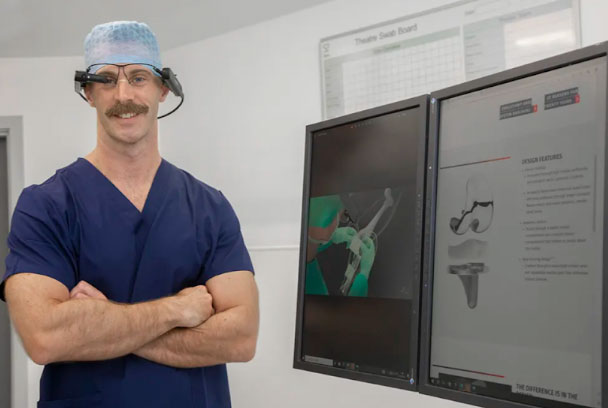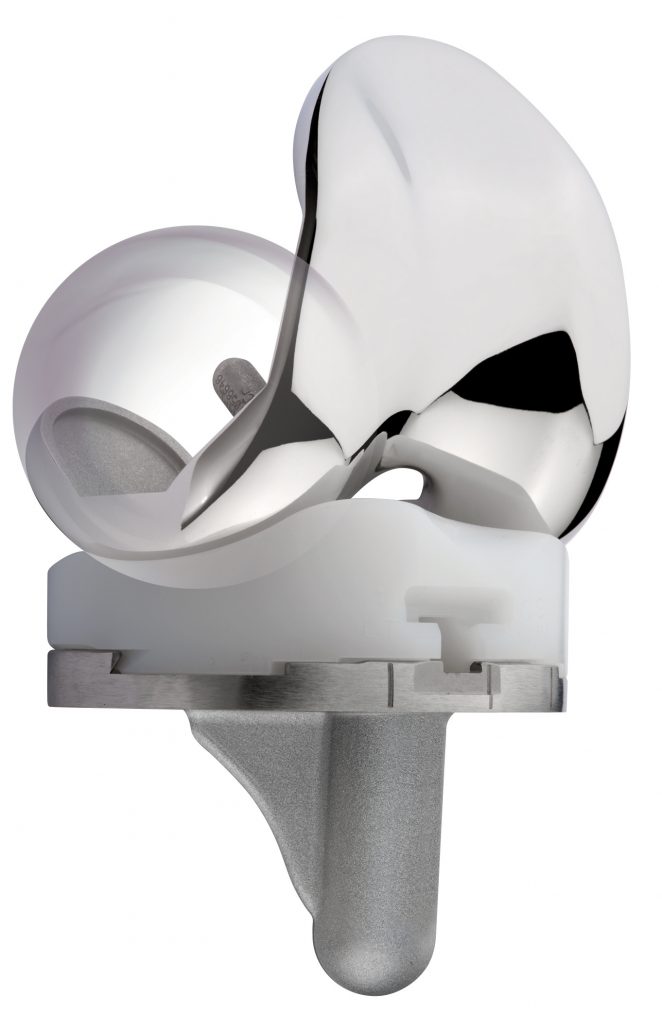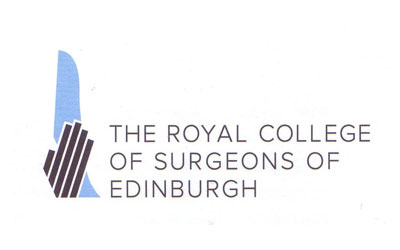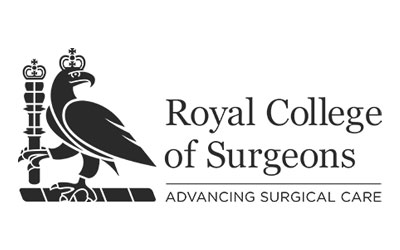EXPERIENCE
Mr Highcock has a specialist interest in the surgical management of knee pain and knee arthritis. He uses the latest Augmented Reality assisted surgery in medial pivot total knee replacement to achieve the best outcomes for his patients. He regularly teaches fellow Consultant Surgeons in these techniques. His outcome data shows shorter length of stay and higher satisfaction scores for his knee replacement patients.
Mr Highcock is the highest volume and leading surgeon in the UK for Augmented Reality Assisted Surgery in combination with the Evolution Knee replacement. He has excellent results demonstrated on the National Joint Registry, with lower revision rates and better outcomes than expected.

WHAT IS KNEE ARTHRITIS?
The major types of arthritis that affect the knee are osteoarthritis, rheumatoid arthritis and post-traumatic arthritis.
OSTEOARTHRITIS
Osteoarthritis is the most common arthritis of the knee. It is a degenerative (wear-and-tear) arthritis that occurs most often in people over 50 years of age, but can occur in younger people.
In osteoarthritis, the cartilage in the knee joint gradually wears away. As the cartilage wears away, the protective space between the bones decreases. This can result in bone rubbing on bone and produce pain.
Osteoarthritis develops slowly and the pain it causes worsens over time.
RHEUMATOID ARTHRITIS
Rheumatoid arthritis is a chronic autoimmune disease that affects multiple joints, including the knee joint. It is typically symmetrical, affecting the same joint on both sides of the body.
In rheumatoid arthritis the membrane that covers the knee joint is inflamed resulting in pain, stiffness and deformity.
POSTTRAUMATIC ARTHRITIS
Post-traumatic arthritis develops after a severe injury to the knee. Examples include fractures around the knee, meniscal tears and ligament injuries which can cause deformity or instability, which over time can result in arthritis.
SYMPTOMS
A knee joint affected by arthritis may be painful, stiff, swollen or deformed. Generally, the pain develops gradually over time, although sudden onset pain can occur – often after a minor injury.
Additionally, the joint may become stiff and swollen, making it difficult to bend and straighten the knee. Weight bearing activity may cause pain to worsen. Loose fragments of cartilage can interfere with the smooth motion of joints. The knee may ‘lock’ or ‘stick’ during movement. It may creak, click, snap or make a grinding noise (crepitus).
Pain may cause a feeling of weakness or buckling in the knee.
Many people with arthritis note increased joint pain with cold weather.
JOINT PRESERVATION SURGERY
OSTEOTOMY SURGERY
Early knee arthritis may be amenable to joint preservation surgery with an osteotomy. This may be a High Tibial Osteotomy (HTO) or Distal Varus Femoral Osteotomy (DVFO). Mr Highcock is Fellowship trained in both procedures.
The aim of joint preservation surgery is to transfer weight from the arthritic part of the knee to a healthier area, to correct poor knee alignment, to prolong the life span of the knee joint and avoid knee replacement in young active patients.
TOTAL KNEE REPLACEMENT
EXPERIENCE
Mr Highcock has a specialist interest in the surgical management of knee pain and knee arthritis. He uses the latest Augmented Reality assisted surgery in medial pivot total knee replacement to achieve the best outcomes for his patients. He regularly teaches fellow Consultant Surgeons in these techniques. His outcome data shows shorter length of stay and higher satisfaction scores for his knee replacement patients.
Mr Highcock is the highest volume and leading surgeon in the UK for Augmented Reality Assisted Surgery in combination with the Evolution Knee replacement. He has excellent results demonstrated on the National Joint Registry, with lower revision rates and better outcomes than expected.
RECOVERY
Mr Highcock runs an enhanced recovery program for most of his knee replacement patients. Patients who are suitable (co-existing medical conditions dependent) are bending their new knee fully and walking the same day of their surgery. He does not use drains, or heavy dressings, which can delay rehabilitation. All patients have local anaesthetic to help with early pain management.
Patients are usually discharged after 1 day.
After the operation patients will most likely need to use crutches for 2-3 weeks.
Rehabilitation with a physiotherapist is important for full recovery. Rehabilitation exercises are begun on the day of surgery and help maintain range of motion in the knee and restore strength.
Patients usually resume full activities 6 weeks after surgery.

MEDIAL PIVOT KNEE REPLACEMENT
PRINCIPLES
The Medial Pivot Knee Replacement is a modern design philosophy in knee replacement surgery that increases stability in a knee replacement, and more accurately reproduces the movements of the normal knee. By replicating the bending, rotating and twisting of a healthy knee, recovery and satisfaction with the knee replacement is higher, and patient report better functional outcomes than other knee replacement designs.
As patients report better stability and better bending, patients are more likely to ‘forget’ they’ve had their knee replaced.
ENHANCED RESULTS
Mr Highcock uses this knee replacement to enhance the outcomes for his patients. He records all his results in knee replacement patients, and has demonstrated higher functional results and higher patient satisfaction with this knee replacement and his surgical technique. He regularly presents on this work.
ENHANCED RECOVERY
Mr Highcock runs an enhanced recovery program for all of his medial pivot knee replacement patients. Patients who are suitable (co-existing medical conditions dependent) are bending their new knee fully and walking the same day of their surgery. He does not use drains, or heavy dressings, which can delay rehabilitation. All patients have local anaesthetic to help with early pain management.
Patients are usually discharged after 1 day.
The Medial Pivot design knee replacement has the added benefit of requiring less functional demand on the quadriceps (thigh) muscle, aiding recovery after surgery. More information is available here.
After the operation patients will most likely need to use crutches for 2-3 weeks.
Rehabilitation with a physiotherapist is important for full recovery. Rehabilitation exercises are begun on the day of surgery and help maintain range of motion in the knee and restore strength.
Patients are usually able to resume full activities 6 weeks after surgery.
UNICOMPARTMENTAL KNEE REPLACEMENT
EXPERIENCE
Mr Highcock has a specialist interest in Unicompartmental Knee Replacement (UKR) surgery. He trained in all aspects of UKR at Wrightington, Liverpool and on Fellowship in Toronto, Canada.
UKR is a surgical option were only one half of the knee has become arthritic. It is a smaller surgical procedure than a total knee replacement with faster recovery.
RECOVERY
Mr Highcock runs an enhanced recovery program for all of his knee unicompartmental replacement patients. Patients who are suitable (co-existing medical conditions dependent) are bending their new half knee fully and walking the same day of their surgery. He does not use drains, or heavy dressings, which can delay rehabilitation. All patients have local anaesthetic to help with early pain management.
Patients are usually discharged after 1 day.
After the operation, patients will most likely need to use crutches for 2-4 weeks.
Rehabilitation with a physiotherapist is important for full recovery. Rehabilitation exercises are begun on the day of surgery and help maintain range of motion in the knee and restore strength.
Patients are usually able to resume full activities 6 weeks after surgery.
REVISION TOTAL KNEE REPLACEMENT
Mr Highcock has a sub-specialist interest in Revision Total Knee Replacement. He trained in revision surgery at Wrightington Hospital and had Fellowship training in revision surgery at both the Cavendish Fellowship in Sheffield and the world-renowned Mount Sinai Hospital in Toronto with Dr Allan Gross and Dr David Backstein.
Mr Highcock deals with all aspects of knee revision surgery and is trained in modern techniques for infection eradication, bone restoration, trabecular metal reconstruction, and joint reconstruction. He has a busy revision practice, with 50-60 revision cases per year, dealing with the most complex and surgically challenging revision cases.







